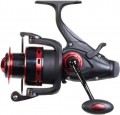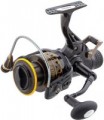Number of bearings
The number of bearings provided in the design of the reel. Bearings are used to reduce friction of rotating parts, which, on the one hand, protects such parts from wear, and on the other hand, reduces excessive effort expended when the handle is rotated. Accordingly, the
more bearings, the more friction units are protected and the better the coil is “optimized”; this parameter is a good indicator of the overall class of the product. At the same time, it is necessary to evaluate different models taking into account their purpose (see "Type").
So, in fly fishing reels, even quite expensive ones, 1 bearing is usually provided — at the point of installation of the drum on a bracket designed for attachment to the rod. This is actually the only significant friction point, so more bearings are simply not required. For multiplier reels, this number varies from 1 for relatively simple options to 6 – 7 for premium ones. And in inertia-free bearings, the number of bearings can reach a couple of dozen.
Spool size
The size of the main spool (drum) of the reel. This parameter directly affects the weight of the coil and its resistance to stress. It uses a symbol in thousands; in order not to go into unnecessary details, we can say that the larger the number in such a designation, the larger and heavier the drum. For different purposes, different sizes will be optimal. So, spools for 2500 – 3000 are considered universal, they can be used for both float fishing and spinning fishing in simple conditions. The smaller size is recommended for light tackle, including ultralight category, and equipment for large and heavy prey (for example, when fishing for carp) may include reels for 4500 – 5000 and
even more.
Spool capacity
The amount of line that can fit on the main spool of a reel with normal winding. It is indicated as a ratio of two numbers, the first of which corresponds to the length of the reeled line in metres, and the second to the thickness in millimetres: for example, the numbers 200 / 0.45 indicate that up to 200 m of fishing line with a thickness of 0.45 mm can fit on the reel.
For different types of fishing, there are recommendations on the optimal value of this parameter; they can be found in special sources. Here we note that the capacity of the spool is indicated exclusively for a smooth fishing line; when using a braided cord, the actual performance may differ markedly.
Spare spool material
The material of the
spare spool(drum) supplied with the reel.
Additional interchangeable spools are provided to expand the capabilities of the reel: if necessary, you can quickly replace the fishing line with tackle of a different thickness (or the same one instead of a broken one), install a reduced drum to increase the casting distance, etc. As for the materials for such spools (
plastic,
aluminium,
graphite), they do not differ from those used in the main drums; see the relevant paragraph above for more details.
Weight
The total weight of the reel (only the device itself, without fishing line). This parameter is important, first of all, for those who select equipment of
the ultralight class — in such gear, the struggle is, as they say, for every extra gram. In other cases, you can not pay special attention to weight.

